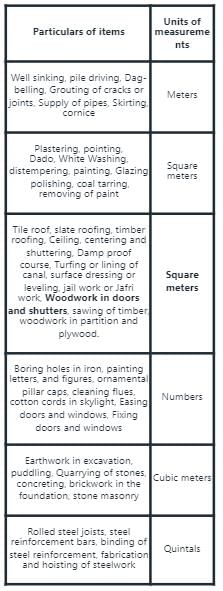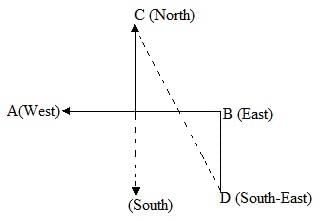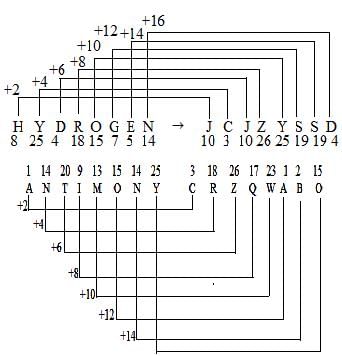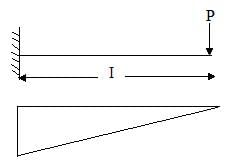All Exams >
Civil Engineering (CE) >
SSC JE Civil Engineering 2025 Mock Test Series >
All Questions
All questions of Full Mock Test Series for Civil Engineering (CE) Exam
Decomposers include-- a)Bacteria
- b)Fungi
- c)Both Bacteria and Fungi
- d)Animals
Correct answer is option 'C'. Can you explain this answer?
Decomposers include-
a)
Bacteria
b)
Fungi
c)
Both Bacteria and Fungi
d)
Animals
|
|
Aarav Sharma answered |
Decomposers play a crucial role in breaking down organic matter into simpler substances, thus recycling nutrients back into the ecosystem. They are responsible for the decomposition and decay of dead organisms and organic waste, helping to maintain the balance of nutrients in the environment. Decomposers include both bacteria and fungi, making option C (Both Bacteria and Fungi) the correct answer.
Bacteria as Decomposers:
- Bacteria are microscopic, single-celled organisms that are found almost everywhere on Earth, including in soil, water, and the human body.
- They are highly efficient decomposers and are able to break down a wide variety of organic matter, including dead plants, animals, and other organic waste.
- Bacteria secrete enzymes that break down complex organic compounds into simpler molecules, such as carbon dioxide, water, and minerals.
- These simpler molecules can then be taken up by other organisms or reabsorbed by plants for their growth and development.
Fungi as Decomposers:
- Fungi are a diverse group of organisms that include molds, yeasts, and mushrooms.
- They obtain their nutrients by breaking down organic matter externally and absorbing the simpler molecules that are released.
- Fungi produce enzymes that break down complex organic compounds, such as cellulose and lignin, which are found in plant material.
- This allows them to decompose dead plant material, including leaves, wood, and other plant debris.
- Fungi play a crucial role in nutrient cycling, as they help release nutrients locked in organic matter back into the soil, making them available for other organisms to use.
Importance of Decomposers:
- Decomposers are essential for the functioning of ecosystems, as they break down dead organisms and organic waste, releasing nutrients that can be reused by other organisms.
- Without decomposers, organic matter would accumulate, and nutrients would become locked up and unavailable for other organisms.
- Decomposers also help in the process of bioremediation, which involves the breakdown of pollutants and toxins in the environment.
In conclusion, decomposers include both bacteria and fungi. They play a vital role in the recycling of nutrients and the breakdown of organic matter in ecosystems.
Bacteria as Decomposers:
- Bacteria are microscopic, single-celled organisms that are found almost everywhere on Earth, including in soil, water, and the human body.
- They are highly efficient decomposers and are able to break down a wide variety of organic matter, including dead plants, animals, and other organic waste.
- Bacteria secrete enzymes that break down complex organic compounds into simpler molecules, such as carbon dioxide, water, and minerals.
- These simpler molecules can then be taken up by other organisms or reabsorbed by plants for their growth and development.
Fungi as Decomposers:
- Fungi are a diverse group of organisms that include molds, yeasts, and mushrooms.
- They obtain their nutrients by breaking down organic matter externally and absorbing the simpler molecules that are released.
- Fungi produce enzymes that break down complex organic compounds, such as cellulose and lignin, which are found in plant material.
- This allows them to decompose dead plant material, including leaves, wood, and other plant debris.
- Fungi play a crucial role in nutrient cycling, as they help release nutrients locked in organic matter back into the soil, making them available for other organisms to use.
Importance of Decomposers:
- Decomposers are essential for the functioning of ecosystems, as they break down dead organisms and organic waste, releasing nutrients that can be reused by other organisms.
- Without decomposers, organic matter would accumulate, and nutrients would become locked up and unavailable for other organisms.
- Decomposers also help in the process of bioremediation, which involves the breakdown of pollutants and toxins in the environment.
In conclusion, decomposers include both bacteria and fungi. They play a vital role in the recycling of nutrients and the breakdown of organic matter in ecosystems.
Out of 100 families in the neighbourhood, 50 have radios, 75 have TVs and 25 have VCRs only 10 families have all three and each VCR owner also has a TV. If some families have radio only, how many have only TV?- a)30
- b)35
- c)40
- d)45
Correct answer is option 'C'. Can you explain this answer?
Out of 100 families in the neighbourhood, 50 have radios, 75 have TVs and 25 have VCRs only 10 families have all three and each VCR owner also has a TV. If some families have radio only, how many have only TV?
a)
30
b)
35
c)
40
d)
45
|
|
Aisha Gupta answered |
The venn diagram of given data is:-

Families have T.V. only (=75 − (2510) = 40)
Hence the option C is correct.
What will be the cant deficiency (cm), if maximum safe speed on a 5 Degree curve of a broad gauge track is 110 km/h and average speed of train is 85 km/h?- a)6.3
- b)10
- c)12.6
- d)18.7
Correct answer is option 'B'. Can you explain this answer?
What will be the cant deficiency (cm), if maximum safe speed on a 5 Degree curve of a broad gauge track is 110 km/h and average speed of train is 85 km/h?
a)
6.3
b)
10
c)
12.6
d)
18.7
|
|
Rajesh Khanna answered |
given, dergee = 5
max. safe speed (Vmax) = 110km/hr
average speed(Vavg) = 85km/hr
For brouad gauge,
G= 1750 mm
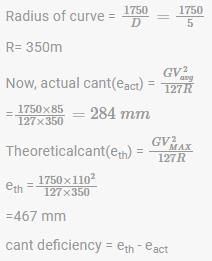
= 486-284=192=19
But, max cant deficiency allowed (as per old IS code) is 10 cm.
max. safe speed (Vmax) = 110km/hr
average speed(Vavg) = 85km/hr
For brouad gauge,
G= 1750 mm

= 486-284=192=19
But, max cant deficiency allowed (as per old IS code) is 10 cm.
Bearing stiffeners are designed as:- a)Beam
- b)Beam life
- c)Ties
- d)Column
Correct answer is option 'D'. Can you explain this answer?
Bearing stiffeners are designed as:
a)
Beam
b)
Beam life
c)
Ties
d)
Column

|
Bank Exams India answered |
The combined effect of forces from moment and shear should be considered while designing fasteners or welds for end connections of girders, beams, and trusses. When flanges or moment connection plates for end connections of beams and girders are welded to the flange of an I- or H-shape column, a pair of column-web stiffeners having a combined cross-sectional area Ast not less than that calculated from the following equations must be provided whenever the calculated value of Ast is positive

Ganesh cycles towards South-West a distance of 8m, then he moves towards East a distance of 20m. From there he moves towards North-East a distance of 8m, then he moves towards West a distance of 6m. From there he moves towards North-East a distance of 2m. Then he moves towards West a distance of 4 m and then towards South-West 2m and stops at that point. How fat is he from the starting point?- a)12m
- b)10m
- c)8m
- d)6m
Correct answer is option 'B'. Can you explain this answer?
Ganesh cycles towards South-West a distance of 8m, then he moves towards East a distance of 20m. From there he moves towards North-East a distance of 8m, then he moves towards West a distance of 6m. From there he moves towards North-East a distance of 2m. Then he moves towards West a distance of 4 m and then towards South-West 2m and stops at that point. How fat is he from the starting point?
a)
12m
b)
10m
c)
8m
d)
6m
|
|
Rhea Reddy answered |
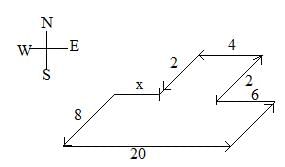
From diagram
distance from starting point
(=20−10) (=10m.)
Hence the option B is correct.
K is a place which is located 2 km away in the northwest direction from the capital P, R is another placer that is located 2 km away in the south-west direction from K. M is another place, and that is located 2 km away in the north-west direction from R. T is yet another place that is located 2 km away in the South-west direction from M. In which direction is T located in relation to P?- a)South-west
- b)North-west
- c)West
- d)North
Correct answer is option 'C'. Can you explain this answer?
K is a place which is located 2 km away in the northwest direction from the capital P, R is another placer that is located 2 km away in the south-west direction from K. M is another place, and that is located 2 km away in the north-west direction from R. T is yet another place that is located 2 km away in the South-west direction from M. In which direction is T located in relation to P?
a)
South-west
b)
North-west
c)
West
d)
North

|
Engineers Adda answered |
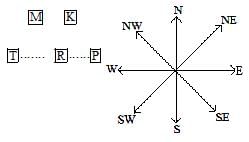
T is located to the West of P.
Hence the correct answer is option C.
Pinky walks a distance of 600 mtr. towards East, turns left, and moves 500 mtr. Then turns left and walks 600 mtr and then turns left again and moves 500 mtr and halts. At what distance in meters is she from the starting point?- a)500
- b)600
- c)0
- d)2200
Correct answer is option 'C'. Can you explain this answer?
Pinky walks a distance of 600 mtr. towards East, turns left, and moves 500 mtr. Then turns left and walks 600 mtr and then turns left again and moves 500 mtr and halts. At what distance in meters is she from the starting point?
a)
500
b)
600
c)
0
d)
2200
|
|
Aisha Gupta answered |
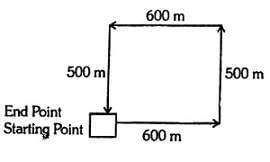
Therefore, since starting point is also the end point; Pinky
is 0 Km distance from the starting point.
Direction: In each of the following questions, select the related word/letters/number from the given alternatives.Bank: Money:: Transport: ?- a)Goods
- b)Road
- c)Speed
- d)Traffic
Correct answer is option 'A'. Can you explain this answer?
Direction: In each of the following questions, select the related word/letters/number from the given alternatives.
Bank: Money:: Transport: ?
a)
Goods
b)
Road
c)
Speed
d)
Traffic
|
|
Tanvi Shah answered |
Transaction of money is done by the bank.
Similarly, the Transaction of goods is done by transport.
The gross bearing capacity of a 1.5 m wide strip footing at a depth of 1.0 m is (430kN/m2). If (γ = 20kN/m2), what is the net bearing capacity?- a)(410kN/m2)
- b)(420kN/m2)
- c)(460kN/m2)
- d)None of these
Correct answer is option 'A'. Can you explain this answer?
The gross bearing capacity of a 1.5 m wide strip footing at a depth of 1.0 m is (430kN/m2). If (γ = 20kN/m2), what is the net bearing capacity?
a)
(410kN/m2)
b)
(420kN/m2)
c)
(460kN/m2)
d)
None of these

|
Knowledge Hub answered |
Total bearing capacity - (4s)
Net bearing capacity - (4rs)
depth of footing - (D f)

The distribution system in water supplies is designed on the basis of:- a)average daily demand
- b)peak hourly demand
- c)coincident of draft
- d)greater of (b) and (c)
Correct answer is option 'D'. Can you explain this answer?
The distribution system in water supplies is designed on the basis of:
a)
average daily demand
b)
peak hourly demand
c)
coincident of draft
d)
greater of (b) and (c)
|
|
Rhea Reddy answered |
The distribution system in water supply is designed for the maximum of (i) peak hourly demand and (ii) Coincidental draft, which is the summation of fire demand and peak daily demand.
The strength based the classification of a brick is made on the basis of following- a)IS:3101
- b)IS:3102
- c)IS:3102
- d)IS : 3496
Correct answer is option 'B'. Can you explain this answer?
The strength based the classification of a brick is made on the basis of following
a)
IS:3101
b)
IS:3102
c)
IS:3102
d)
IS : 3496
|
|
Aarav Sharma answered |
Strength Based Classification of Bricks
IS: 3102 is the Indian Standard code for the classification of burnt clay solid bricks based on their compressive strength. The strength-based classification of bricks is done to ensure the quality of bricks used in construction. The compressive strength of bricks is an important parameter to determine the quality of bricks. The strength-based classification of bricks is done on the basis of the following factors:
Factors for strength based classification of bricks
1. Compressive strength: The compressive strength of bricks is determined by applying a compressive load on a brick until it fails. The compressive strength of bricks is expressed in N/mm2 or MPa.
2. Water absorption: The water absorption of bricks is determined by immersing a brick in water for 24 hours and then weighing it. The water absorption of bricks is expressed as a percentage of the dry weight of the brick.
3. Efflorescence: Efflorescence is the white salt deposits that form on the surface of bricks due to the presence of soluble salts. The efflorescence of bricks is determined by placing a brick in a tray and adding water to the tray. The water is then allowed to evaporate and the amount of salt deposits on the surface of the brick is measured.
4. Dimensional tolerance: The dimensional tolerance of bricks is measured by checking the length, width, and height of the bricks. The dimensional tolerance of bricks is expressed as a percentage of the specified size of the brick.
5. Warpage: Warpage is the deviation of the brick from a straight line. The warpage of bricks is determined by placing a straight edge on the surface of the brick and measuring the deviation.
Classification of Bricks
Based on the compressive strength of bricks, they are classified into the following categories:
1. Class A: These are the highest quality bricks with a compressive strength of more than 100 N/mm2.
2. Class B: These are medium quality bricks with a compressive strength between 70 N/mm2 and 100 N/mm2.
3. Class C: These are low-quality bricks with a compressive strength between 35 N/mm2 and 70 N/mm2.
4. Class D: These are the lowest quality bricks with a compressive strength of less than 35 N/mm2.
Conclusion
Thus, the strength-based classification of bricks is an important factor in determining the quality of bricks used in construction. The compressive strength of bricks is an important parameter in this classification, and it is determined by applying a compressive load on a brick until it fails. Based on the compressive strength, bricks are classified into different categories, and the quality of bricks is ensured by checking various parameters like water absorption, efflorescence, dimensional tolerance, and warpage.
IS: 3102 is the Indian Standard code for the classification of burnt clay solid bricks based on their compressive strength. The strength-based classification of bricks is done to ensure the quality of bricks used in construction. The compressive strength of bricks is an important parameter to determine the quality of bricks. The strength-based classification of bricks is done on the basis of the following factors:
Factors for strength based classification of bricks
1. Compressive strength: The compressive strength of bricks is determined by applying a compressive load on a brick until it fails. The compressive strength of bricks is expressed in N/mm2 or MPa.
2. Water absorption: The water absorption of bricks is determined by immersing a brick in water for 24 hours and then weighing it. The water absorption of bricks is expressed as a percentage of the dry weight of the brick.
3. Efflorescence: Efflorescence is the white salt deposits that form on the surface of bricks due to the presence of soluble salts. The efflorescence of bricks is determined by placing a brick in a tray and adding water to the tray. The water is then allowed to evaporate and the amount of salt deposits on the surface of the brick is measured.
4. Dimensional tolerance: The dimensional tolerance of bricks is measured by checking the length, width, and height of the bricks. The dimensional tolerance of bricks is expressed as a percentage of the specified size of the brick.
5. Warpage: Warpage is the deviation of the brick from a straight line. The warpage of bricks is determined by placing a straight edge on the surface of the brick and measuring the deviation.
Classification of Bricks
Based on the compressive strength of bricks, they are classified into the following categories:
1. Class A: These are the highest quality bricks with a compressive strength of more than 100 N/mm2.
2. Class B: These are medium quality bricks with a compressive strength between 70 N/mm2 and 100 N/mm2.
3. Class C: These are low-quality bricks with a compressive strength between 35 N/mm2 and 70 N/mm2.
4. Class D: These are the lowest quality bricks with a compressive strength of less than 35 N/mm2.
Conclusion
Thus, the strength-based classification of bricks is an important factor in determining the quality of bricks used in construction. The compressive strength of bricks is an important parameter in this classification, and it is determined by applying a compressive load on a brick until it fails. Based on the compressive strength, bricks are classified into different categories, and the quality of bricks is ensured by checking various parameters like water absorption, efflorescence, dimensional tolerance, and warpage.
Little wooden cubes, each with a side of one inch, are put together to form a solid cube with a side of three inches. This big cube is then painted red all over on the outside. When the big cube is broken up into the original little ones, how many cubes will have paint on two sides?- a)4
- b)8
- c)12
- d)0
Correct answer is option 'B'. Can you explain this answer?
Little wooden cubes, each with a side of one inch, are put together to form a solid cube with a side of three inches. This big cube is then painted red all over on the outside. When the big cube is broken up into the original little ones, how many cubes will have paint on two sides?
a)
4
b)
8
c)
12
d)
0

|
Knowledge Hub answered |
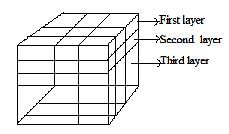
4 cubes, each of the first and third layers, will have paint on two sides only.
Therefore, the total number of cubes having paint on two sides
=4 ×2=8
Hence the correct answer is option B.
Name a single letter which can be prefixed to the following words in order to obtain entirely new words?TILL, TABLE PILE, TAB PRING- a)S
- b)C
- c)H
- d)B
Correct answer is option 'A'. Can you explain this answer?
Name a single letter which can be prefixed to the following words in order to obtain entirely new words?
TILL, TABLE PILE, TAB PRING
a)
S
b)
C
c)
H
d)
B
|
|
Aarav Sharma answered |
Answer:
To find a single letter that can be prefixed to the given words to form new words, we need to consider the meaning and structure of the original words and the resulting words.
Original Words:
- TILL
- TABLE
- PILE
- TAB
- PRING
Prefixing a Single Letter:
- The letter needs to be added at the beginning of each word to form a new word.
- The new word should have a different meaning compared to the original word.
Possible Prefixes:
a) S
b) C
c) H
d) B
Analysis:
Let's analyze each option and see if the resulting words are new and have different meanings compared to the original words.
a) S:
- STILL: This is a new word with a different meaning compared to TILL. It refers to something that is not moving or making a sound.
- STABLE: This is a new word with a different meaning compared to TABLE. It refers to something that is firm and steady.
- SPILE: This is a new word with a different meaning compared to PILE. It refers to a small pointed object used to make a hole.
- STAB: This is a new word with a different meaning compared to TAB. It refers to an act of stabbing or thrusting with a sharp object.
- SPRING: This is a new word with a different meaning compared to PRING. It refers to a season or a device that stores mechanical energy.
Conclusion:
Among the given options, adding the letter 'S' as a prefix to the original words results in entirely new words with different meanings. Therefore, the correct answer is option 'A' - S.
To find a single letter that can be prefixed to the given words to form new words, we need to consider the meaning and structure of the original words and the resulting words.
Original Words:
- TILL
- TABLE
- PILE
- TAB
- PRING
Prefixing a Single Letter:
- The letter needs to be added at the beginning of each word to form a new word.
- The new word should have a different meaning compared to the original word.
Possible Prefixes:
a) S
b) C
c) H
d) B
Analysis:
Let's analyze each option and see if the resulting words are new and have different meanings compared to the original words.
a) S:
- STILL: This is a new word with a different meaning compared to TILL. It refers to something that is not moving or making a sound.
- STABLE: This is a new word with a different meaning compared to TABLE. It refers to something that is firm and steady.
- SPILE: This is a new word with a different meaning compared to PILE. It refers to a small pointed object used to make a hole.
- STAB: This is a new word with a different meaning compared to TAB. It refers to an act of stabbing or thrusting with a sharp object.
- SPRING: This is a new word with a different meaning compared to PRING. It refers to a season or a device that stores mechanical energy.
Conclusion:
Among the given options, adding the letter 'S' as a prefix to the original words results in entirely new words with different meanings. Therefore, the correct answer is option 'A' - S.
Which of the following statements is true?- a)Shear stress on principal planes is zero.
- b)Shear stress on principal planes is maximum
- c)Shear stress on principal planes is minimum.
- d)None of these
Correct answer is option 'A'. Can you explain this answer?
Which of the following statements is true?
a)
Shear stress on principal planes is zero.
b)
Shear stress on principal planes is maximum
c)
Shear stress on principal planes is minimum.
d)
None of these
|
|
Aisha Gupta answered |
Shear Stress on the principal plane is zero as shown in the figure. In the figure shown below X-axis represent the normal stress and Y-axis represents the shear stress. Since the horizontal X-axis also represents the maximum principal plane, therefore, shear stress (Y-value) will be zero on this plane.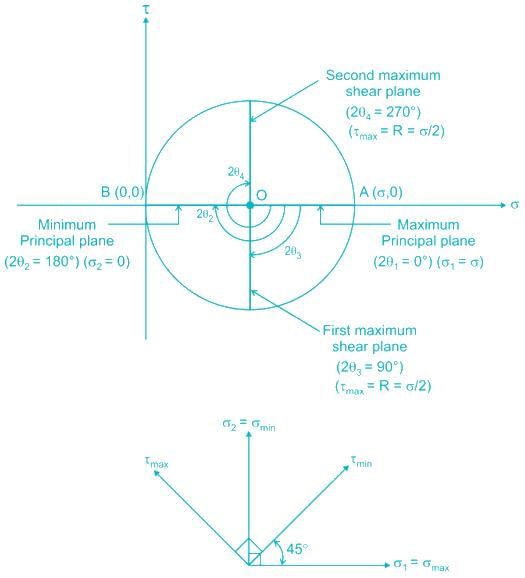

Ductility of which of the following is the maximum?- a)Mild steel
- b)Cost iron
- c)Wrought iron
- d)Pig iron
Correct answer is option 'C'. Can you explain this answer?
Ductility of which of the following is the maximum?
a)
Mild steel
b)
Cost iron
c)
Wrought iron
d)
Pig iron

|
Naroj Boda answered |
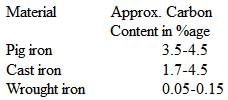
Steel 0.25-1.5
Hence Ductility maximum in Wrought iron.
Hence the option C is correct.
A sample of wet soil has a mass of 12kg. On over-drying the mass reduces to 10kg, the water content of the soil is-- a)2.0%
- b)20.0%
- c)16.67%
- d)None of the above
Correct answer is option 'C'. Can you explain this answer?
A sample of wet soil has a mass of 12kg. On over-drying the mass reduces to 10kg, the water content of the soil is-
a)
2.0%
b)
20.0%
c)
16.67%
d)
None of the above

|
Rakesh Meena answered |
W=12, Ws=10,
Ww=W-Ws=12-10=2,
Then,
W.C = Ww/Ws = 2/10 = 0.2%W.C= 0.2x100=20%
Correct answer is option 'B'.
Please Correction this question.
Addition cover thickness in reinforced cement concrete members totally immersed in seawater is-- a)25 mm
- b)30 mm
- c)35 mm
- d)40 mm
Correct answer is option 'D'. Can you explain this answer?
Addition cover thickness in reinforced cement concrete members totally immersed in seawater is-
a)
25 mm
b)
30 mm
c)
35 mm
d)
40 mm
|
|
Tanvi Shah answered |
For reinforced concrete members totally immersed in seawater, the cover shall be 40 mm more than that.
For reinforced concrete members, periodically immersed in seawater or subject to sea spray, the cover of concrete shall be 50 mm more than that.
For concrete of grade M 25 and above, the additional thickness of cover specified above may be reduced to half. In all such cases, the cover should not exceed 75 mm.
Hence the option D is correct.
For M 150 grade of concrete (1 : 2 : 4) the moment of resistance factor is ________?- a)0.87
- b)8.5
- c)7.5
- d)5.8
Correct answer is option 'A'. Can you explain this answer?
For M 150 grade of concrete (1 : 2 : 4) the moment of resistance factor is ________?
a)
0.87
b)
8.5
c)
7.5
d)
5.8

|
Knowledge Hub answered |
Moment of resistance factor is given by

Where,
c = permissible compressive bending stress in concrete (depends upon grade of concrete)
c = 5 N/mm2 for M150 grade of concrete
j = liver arm depth factor = 1 - k/3
k = Neutral axis depth factor = mc/(mc + t)
m = modular ratio = 

σcbc = 5 N/mm2
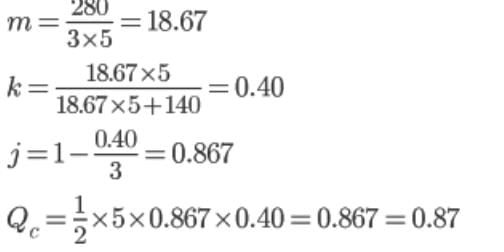
K is a place which is located 2 km away in the northwest direction from the capital P, R is another place that is located 2 km away in the south-west direction from K. M is another place and that is located 2 km away in the north-west direction from R. T is yet another place that is located 2 km away in the South-west direction from M. In which direction is T located in relation to P?- a)South-west
- b)North-west
- c)West
- d)North
Correct answer is option 'C'. Can you explain this answer?
K is a place which is located 2 km away in the northwest direction from the capital P, R is another place that is located 2 km away in the south-west direction from K. M is another place and that is located 2 km away in the north-west direction from R. T is yet another place that is located 2 km away in the South-west direction from M. In which direction is T located in relation to P?
a)
South-west
b)
North-west
c)
West
d)
North
|
|
Rhea Reddy answered |
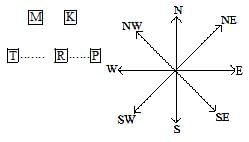
It is clear that T is located to the West of P.
The ratio between stress and strain is called as-- a)Modulus of elasticity
- b)Modulus of rigidity
- c)Bulk modulus
- d)None of the above
Correct answer is option 'A'. Can you explain this answer?
The ratio between stress and strain is called as-
a)
Modulus of elasticity
b)
Modulus of rigidity
c)
Bulk modulus
d)
None of the above

|
Ankit Dubey answered |
It is the definition of Hooke's Law and since nothing in said about the type of stress or strain so, we consider it tensile/ compressive stress and strain.
Shallow pits should be provided with lateral support when depth exceeds-- a)2 m
- b)2.5 m
- c)3.0 m
- d)3.5 m
Correct answer is option 'C'. Can you explain this answer?
Shallow pits should be provided with lateral support when depth exceeds-
a)
2 m
b)
2.5 m
c)
3.0 m
d)
3.5 m

|
Bank Exams India answered |
Shallow pits with lateral support should be provided if the depth exceeds 3.0 m.
Direction: In each of the following questions, select the related word/letters/number from the given alternatives.Patrol : Security : : Insurance : ?- a)Money
- b)Policy
- c)Savings
- d)Risk
Correct answer is option 'D'. Can you explain this answer?
Direction: In each of the following questions, select the related word/letters/number from the given alternatives.
Patrol : Security : : Insurance : ?
a)
Money
b)
Policy
c)
Savings
d)
Risk
|
|
Rajesh Khanna answered |
To ensure security, police or defense personnel patrol the area. Similarly, to cover risk, insurance is done.
Hence the correct answer is option D.
A soil sample has liquid limit as 45%, plastic limit as 25% and shrinkage limit as 14%. For a natural water content of 30, the liquidity index of the soil will be- a)75%
- b)80%
- c)25%
- d)None of these
Correct answer is option 'C'. Can you explain this answer?
A soil sample has liquid limit as 45%, plastic limit as 25% and shrinkage limit as 14%. For a natural water content of 30, the liquidity index of the soil will be
a)
75%
b)
80%
c)
25%
d)
None of these
|
|
Aisha Gupta answered |

Hence, the correct option is (C)
In an adjustment level, when the bubble centred, the axis of the bubble tube become parallel to -- a)Line of sight
- b)Line of collimation
- c)Axis of the telescope
- d)None of these
Correct answer is option 'A'. Can you explain this answer?
In an adjustment level, when the bubble centred, the axis of the bubble tube become parallel to -
a)
Line of sight
b)
Line of collimation
c)
Axis of the telescope
d)
None of these
|
|
Aarav Sharma answered |
Explanation:
- In surveying, the bubble tube is an important component of the level instrument. It contains a liquid (usually alcohol or ether) with a small bubble that moves within it.
- The purpose of the bubble tube is to indicate whether the level instrument is horizontal or not. When the bubble is centred, it indicates that the level instrument is horizontal, and adjustments can be made accordingly.
- However, it is important to note that the bubble tube does not indicate the direction of the horizontal plane. In other words, it only indicates whether the level instrument is level, but not whether it is aligned with a specific reference.
- To align the level instrument with a specific reference, such as a benchmark or a known elevation, adjustments must be made to the level instrument using the leveling screws or knobs.
- One of the important adjustments that must be made is the adjustment of the line of sight. The line of sight is the imaginary line that connects the eyepiece of the level instrument to the target or object being observed.
- When the bubble is centred, the axis of the bubble tube becomes parallel to the line of sight. This means that the line of sight is horizontal and parallel to the level instrument.
- However, it is important to note that the line of sight does not necessarily coincide with the line of collimation or the optical axis of the telescope. The line of collimation is the imaginary line that passes through the center of the objective lens, the center of the crosshairs or reticle, and the center of the eyepiece. The optical axis of the telescope is the imaginary line that passes through the center of the objective lens and the center of the eyepiece.
- Therefore, while the bubble tube indicates that the level instrument is level and the line of sight is horizontal, adjustments must still be made to ensure that the line of collimation or the optical axis of the telescope is aligned with the reference being used.
- In summary, when the bubble is centred, the axis of the bubble tube becomes parallel to the line of sight, indicating that the level instrument is level and the line of sight is horizontal. However, adjustments must still be made to ensure that the line of collimation or the optical axis of the telescope is aligned with the reference being used.
- In surveying, the bubble tube is an important component of the level instrument. It contains a liquid (usually alcohol or ether) with a small bubble that moves within it.
- The purpose of the bubble tube is to indicate whether the level instrument is horizontal or not. When the bubble is centred, it indicates that the level instrument is horizontal, and adjustments can be made accordingly.
- However, it is important to note that the bubble tube does not indicate the direction of the horizontal plane. In other words, it only indicates whether the level instrument is level, but not whether it is aligned with a specific reference.
- To align the level instrument with a specific reference, such as a benchmark or a known elevation, adjustments must be made to the level instrument using the leveling screws or knobs.
- One of the important adjustments that must be made is the adjustment of the line of sight. The line of sight is the imaginary line that connects the eyepiece of the level instrument to the target or object being observed.
- When the bubble is centred, the axis of the bubble tube becomes parallel to the line of sight. This means that the line of sight is horizontal and parallel to the level instrument.
- However, it is important to note that the line of sight does not necessarily coincide with the line of collimation or the optical axis of the telescope. The line of collimation is the imaginary line that passes through the center of the objective lens, the center of the crosshairs or reticle, and the center of the eyepiece. The optical axis of the telescope is the imaginary line that passes through the center of the objective lens and the center of the eyepiece.
- Therefore, while the bubble tube indicates that the level instrument is level and the line of sight is horizontal, adjustments must still be made to ensure that the line of collimation or the optical axis of the telescope is aligned with the reference being used.
- In summary, when the bubble is centred, the axis of the bubble tube becomes parallel to the line of sight, indicating that the level instrument is level and the line of sight is horizontal. However, adjustments must still be made to ensure that the line of collimation or the optical axis of the telescope is aligned with the reference being used.
A submerged pipe outlet is an example of- a)Semi-modular outlet
- b)Non-modular outlet
- c)Rigid modular
- d)Adjustable proportional module
Correct answer is option 'B'. Can you explain this answer?
A submerged pipe outlet is an example of
a)
Semi-modular outlet
b)
Non-modular outlet
c)
Rigid modular
d)
Adjustable proportional module
|
|
Rajesh Khanna answered |
Submerged pipe outlet is a non-modular type of outlet so the discharge depends upon the water level in both the minor and well chamber.

Thus discharge through outlet can be increased by increasing HL or by increasing the depth of water in the minor. If there is any drop in the water level in the minor, the HL and discharge will decrease.
The other common examples of this type of outlet are
a) Open Sluice
b) Drowned pipe outlet
If 73 + 46 = 42 and 95 + 87 = 57, then 62 + 80 = ?- a)32
- b)48
- c)64
- d)36
Correct answer is option 'D'. Can you explain this answer?
If 73 + 46 = 42 and 95 + 87 = 57, then 62 + 80 = ?
a)
32
b)
48
c)
64
d)
36
|
|
Aisha Gupta answered |
73+46=42
first subtract first number digits= 7-3=4
then add second number digits = 4+6=10
then add the both answers of subtract & addition 4+10=14
then multiply this answer by 3= 14 × 3=42
95+87=?
9-5=4
8+7=15
15+4=19
19 × 3=57
62+80=?
6-2=4
8+0=8
8+4=12
12 × 3=36
If the quadrantal bearing of a line is N25∘W, then the Whole Circle Bearing of the line is- a)S250E
- b)2050
- c)3350
- d)2950
Correct answer is option 'C'. Can you explain this answer?
If the quadrantal bearing of a line is N25∘W, then the Whole Circle Bearing of the line is
a)
S250E
b)
2050
c)
3350
d)
2950
|
|
Rhea Reddy answered |

Quadrantal circle bearing = N 25∘W
Whole circle bearing =360∘−25∘=335∘
Hence, the correct option is (c).
Which of the example for Plural Executive?- a)The U.S.A.
- b)The U.K.
- c)India
- d)Switzerland
Correct answer is option 'D'. Can you explain this answer?
Which of the example for Plural Executive?
a)
The U.S.A.
b)
The U.K.
c)
India
d)
Switzerland
|
|
Aisha Gupta answered |
A plural executive is a system of government where several or all of the administrative branch officers, are elected in their own right. The executive power of the Swiss confederation is vested in a plural executive consisting of seven members known as the Federal Council. According to Article 177 of the Swiss constitution, the Federal Council is a collegial body in which every member enjoys equal power and status.
Hence the correct answer is option D.
Two blocks A and B, each of mass m, are placed on a smooth horizontal surface. Two horizontal forces F and 2F, are applied on blocks A and B, respectively, as shown in Figure. Block a does not slide on block B. Then the normal reaction acting between the two blocks in (assume no friction between the blocks).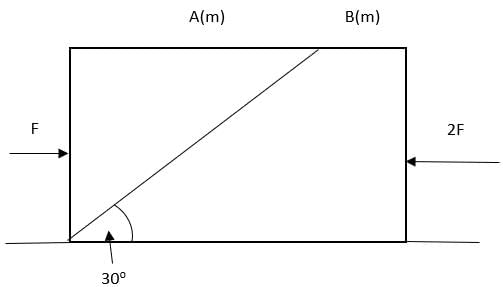
- a)F
- b)f/2
- c)f/√3
- d)3F
Correct answer is option 'D'. Can you explain this answer?
Two blocks A and B, each of mass m, are placed on a smooth horizontal surface. Two horizontal forces F and 2F, are applied on blocks A and B, respectively, as shown in Figure. Block a does not slide on block B. Then the normal reaction acting between the two blocks in (assume no friction between the blocks).

a)
F
b)
f/2
c)
f/√3
d)
3F

|
Knowledge Hub answered |
Consider Both masses as a system,
Total force on system FT = 2F − F = F (Left side)
Mass of system M = 2m
Acceleration of two mass system is a = f/2m towards left free body diagram is
N cos 60 − F = ma

N = 3F
Normal reaction acting between two blocks = N = 3F
Hence, option (D) is the correct answer.
Equivalent area of a reinforced cement concrete section is -- a)(mAcAsc)
- b)(AcmAsc)
- c)(AcAsc)
- d)((AsmAsc)?c
Correct answer is option 'B'. Can you explain this answer?
Equivalent area of a reinforced cement concrete section is -
a)
(mAcAsc)
b)
(AcmAsc)
c)
(AcAsc)
d)
((AsmAsc)?c
|
|
Rajesh Khanna answered |
Equivalent area of a reinforced cement concrete section is -(AcmAsc)
Who is the founder of "Facebook," which is currently the No. 1 social networking website in India?- a)Martin Cooper
- b)Orkut Buyukkokten
- c)Mark Zuckerberg
- d)Bill Gates
Correct answer is option 'C'. Can you explain this answer?
Who is the founder of "Facebook," which is currently the No. 1 social networking website in India?
a)
Martin Cooper
b)
Orkut Buyukkokten
c)
Mark Zuckerberg
d)
Bill Gates
|
|
Aisha Gupta answered |
Zuckerberg launches Facebook as a Harvard-only social network. Zuckerberg, Dustin Moskovitz, and Eduardo Saverin from Thefacebook.com LLC, a partnership.
For fixed support in a plane structure, the total number of reactions is:- a)1
- b)2
- c)3
- d)4
Correct answer is option 'C'. Can you explain this answer?
For fixed support in a plane structure, the total number of reactions is:
a)
1
b)
2
c)
3
d)
4
|
|
Aarav Sharma answered |
Fixed Support in a Plane Structure
A fixed support, also known as a built-in or immovable support, is a type of support used in structural engineering. It prevents both translation and rotation of the structure at the support location. When analyzing a structure with a fixed support, it is important to determine the number of reactions that occur at the support.
Number of Reactions
The number of reactions at a fixed support depends on the degree of freedom of the structure. In a plane structure, there are three degrees of freedom:
1. Translation in the x-direction
2. Translation in the y-direction
3. Rotation about the z-axis
Since a fixed support prevents both translation and rotation, there are three reactions that occur at the support:
1. Vertical reaction force (Fy)
This is the force exerted in the y-direction to prevent vertical translation of the structure. It acts perpendicular to the plane of the structure.
2. Horizontal reaction force (Fx)
This is the force exerted in the x-direction to prevent horizontal translation of the structure. It acts parallel to the plane of the structure.
3. Moment reaction (Mz)
This is the moment exerted about the z-axis to prevent rotation of the structure. It acts perpendicular to the plane of the structure.
Therefore, the total number of reactions at a fixed support in a plane structure is three (Fy, Fx, Mz).
Conclusion
In summary, a fixed support in a plane structure generates three reactions: a vertical reaction force, a horizontal reaction force, and a moment reaction. These reactions are necessary to prevent translation and rotation of the structure at the support location.
A fixed support, also known as a built-in or immovable support, is a type of support used in structural engineering. It prevents both translation and rotation of the structure at the support location. When analyzing a structure with a fixed support, it is important to determine the number of reactions that occur at the support.
Number of Reactions
The number of reactions at a fixed support depends on the degree of freedom of the structure. In a plane structure, there are three degrees of freedom:
1. Translation in the x-direction
2. Translation in the y-direction
3. Rotation about the z-axis
Since a fixed support prevents both translation and rotation, there are three reactions that occur at the support:
1. Vertical reaction force (Fy)
This is the force exerted in the y-direction to prevent vertical translation of the structure. It acts perpendicular to the plane of the structure.
2. Horizontal reaction force (Fx)
This is the force exerted in the x-direction to prevent horizontal translation of the structure. It acts parallel to the plane of the structure.
3. Moment reaction (Mz)
This is the moment exerted about the z-axis to prevent rotation of the structure. It acts perpendicular to the plane of the structure.
Therefore, the total number of reactions at a fixed support in a plane structure is three (Fy, Fx, Mz).
Conclusion
In summary, a fixed support in a plane structure generates three reactions: a vertical reaction force, a horizontal reaction force, and a moment reaction. These reactions are necessary to prevent translation and rotation of the structure at the support location.
Re-oxygenation curve of a polluted stream-- a)Decreases with time
- b)Increases with time
- c)Decreases to a minimum and then increases
- d)Increases to maximum and then decreases
Correct answer is option 'B'. Can you explain this answer?
Re-oxygenation curve of a polluted stream-
a)
Decreases with time
b)
Increases with time
c)
Decreases to a minimum and then increases
d)
Increases to maximum and then decreases
|
|
Aisha Gupta answered |
To counterbalance the consumption of D.O. due to de-oxygenation atmosphere supplies oxygen to the water. This is known as re-Oxygenation. It Increases with the time of flow from the point of pollution.
Hence the correct answer is option B.
A beam is said to have been subjected to a pure bending when-- a)Shear force is constant throughout the span
- b)load is applied as UDL throughout the span
- c)load is applied at the mid-span only
- d)None of the above
Correct answer is option 'A'. Can you explain this answer?
A beam is said to have been subjected to a pure bending when-
a)
Shear force is constant throughout the span
b)
load is applied as UDL throughout the span
c)
load is applied at the mid-span only
d)
None of the above
|
|
Tanvi Shah answered |

Or m = constant
Thus zero shear force implies that the damping is constant at each transverse cut of the rotating constant or beam. This type of situation can be imagined for the beam or part of it while the beam has a load at its ends.
According to IS : 800-1962 the permissible bending stress in steel slab plates is-- a)1500 (km/cm2)
- b)1420 (km/cm2)
- c)2125 (km/cm2)
- d)1890 (km/cm2)
Correct answer is option 'D'. Can you explain this answer?
According to IS : 800-1962 the permissible bending stress in steel slab plates is-
a)
1500 (km/cm2)
b)
1420 (km/cm2)
c)
2125 (km/cm2)
d)
1890 (km/cm2)
|
|
Om Desai answered |
Maximum permissible bending stress in Column is 0.75fy .
so that 0.75 × 250 = 1875 ~1890 Kg/cm2.
Primary treatment of sewage consists of :
- a)Removal of floating materials
- b)Removal of sand and grit
- c)All of these
- d)Removal of organic materials
Correct answer is option 'C'. Can you explain this answer?
Primary treatment of sewage consists of :
a)
Removal of floating materials
b)
Removal of sand and grit
c)
All of these
d)
Removal of organic materials
|
|
Om Desai answered |
In primary treatment of sewage unit firstly removal of suspended organic solid materials.
If S is the length of a sub-chord and R is the radius of circular curve, the angle of deflection between the tangent and sub-chord in minutes, is equal to-- a)573 S/R
- b)573 R/S
- c)1718.9 S/R
- d)1718.9 R/S
Correct answer is option 'C'. Can you explain this answer?
If S is the length of a sub-chord and R is the radius of circular curve, the angle of deflection between the tangent and sub-chord in minutes, is equal to-
a)
573 S/R
b)
573 R/S
c)
1718.9 S/R
d)
1718.9 R/S
|
|
Rhea Reddy answered |
Rekin's method works on the principle that the deflection angle at a point of the circle curve is measured by the angle of the angle subtended by the arc at that point from PC. It is assumed that the arc length is approximately equal to its arc.
A solid circular shaft has been subjected to a pure torsion moment. the ratio of maximum shear stress to maximum normal stress at any point would be -
- a)1 : 1
- b)1 : 2
- c)2 : 3
- d)2 : 1
Correct answer is option 'A'. Can you explain this answer?
A solid circular shaft has been subjected to a pure torsion moment. the ratio of maximum shear stress to maximum normal stress at any point would be -
a)
1 : 1
b)
1 : 2
c)
2 : 3
d)
2 : 1
|
|
Aarav Sharma answered |
Maximum Shear Stress and Maximum Normal Stress in a Circular Shaft under Torsion
When a pure torsion moment is applied to a solid circular shaft, the shaft will experience both shear stress and normal stress. The maximum shear stress and maximum normal stress occur at different points on the shaft.
Maximum Shear Stress
The maximum shear stress occurs at the outer surface of the shaft, where the radius is maximum. This is because the shear stress is directly proportional to the distance from the axis of rotation. At the outer surface, the distance from the axis is maximum, and therefore the shear stress is maximum.
Maximum Normal Stress
The maximum normal stress occurs at the inner surface of the shaft, where the radius is minimum. This is because the normal stress is directly proportional to the distance from the neutral axis. At the inner surface, the distance from the neutral axis is minimum, and therefore the normal stress is maximum.
Ratio of Maximum Shear Stress to Maximum Normal Stress
As the maximum shear stress and maximum normal stress occur at different points on the shaft, the ratio of these stresses is not constant. However, at any point on the shaft, the ratio of maximum shear stress to maximum normal stress is always equal to 1 : 1. This is because the shear stress and normal stress are related by the following equation:
shear stress = normal stress x shear modulus / Young's modulus
As the shear modulus is equal to Young's modulus divided by 2(1 + Poisson's ratio), and Poisson's ratio is typically less than 0.5 for most materials, the shear modulus is always less than the Young's modulus. Therefore, the maximum shear stress is always less than the maximum normal stress, and the ratio of these stresses is always equal to 1 : 1.
Conclusion
In conclusion, when a solid circular shaft is subjected to a pure torsion moment, the maximum shear stress occurs at the outer surface of the shaft, while the maximum normal stress occurs at the inner surface. However, at any point on the shaft, the ratio of maximum shear stress to maximum normal stress is always equal to 1 : 1.
When a pure torsion moment is applied to a solid circular shaft, the shaft will experience both shear stress and normal stress. The maximum shear stress and maximum normal stress occur at different points on the shaft.
Maximum Shear Stress
The maximum shear stress occurs at the outer surface of the shaft, where the radius is maximum. This is because the shear stress is directly proportional to the distance from the axis of rotation. At the outer surface, the distance from the axis is maximum, and therefore the shear stress is maximum.
Maximum Normal Stress
The maximum normal stress occurs at the inner surface of the shaft, where the radius is minimum. This is because the normal stress is directly proportional to the distance from the neutral axis. At the inner surface, the distance from the neutral axis is minimum, and therefore the normal stress is maximum.
Ratio of Maximum Shear Stress to Maximum Normal Stress
As the maximum shear stress and maximum normal stress occur at different points on the shaft, the ratio of these stresses is not constant. However, at any point on the shaft, the ratio of maximum shear stress to maximum normal stress is always equal to 1 : 1. This is because the shear stress and normal stress are related by the following equation:
shear stress = normal stress x shear modulus / Young's modulus
As the shear modulus is equal to Young's modulus divided by 2(1 + Poisson's ratio), and Poisson's ratio is typically less than 0.5 for most materials, the shear modulus is always less than the Young's modulus. Therefore, the maximum shear stress is always less than the maximum normal stress, and the ratio of these stresses is always equal to 1 : 1.
Conclusion
In conclusion, when a solid circular shaft is subjected to a pure torsion moment, the maximum shear stress occurs at the outer surface of the shaft, while the maximum normal stress occurs at the inner surface. However, at any point on the shaft, the ratio of maximum shear stress to maximum normal stress is always equal to 1 : 1.
If the fineness modulus of sand is 2.7, it is geared as,- a)very fine sand
- b)fine sand
- c)medium sand
- d)coarse sand
Correct answer is option 'C'. Can you explain this answer?
If the fineness modulus of sand is 2.7, it is geared as,
a)
very fine sand
b)
fine sand
c)
medium sand
d)
coarse sand
|
|
Aisha Gupta answered |
If the fineness modulus of sand is 2.7, it is geared as medium sand.
Hence the correct answer is option C.
The quantity of water required per 50 kg of cement for nominal mix concrete for M20 is-- a)34
- b)32
- c)30
- d)45
Correct answer is option 'C'. Can you explain this answer?
The quantity of water required per 50 kg of cement for nominal mix concrete for M20 is-
a)
34
b)
32
c)
30
d)
45
|
|
Aisha Gupta answered |
According to IS: 450 : 2000
Grade of concrete per volume of water 50 kg
MS - 60
M7.5 - 45
M10 - 34
M15 - 32
M20 - 30
What is the specific energy (m-kg/kg) for 1 m depth of flow having velocity of 3 m/s?- a)0.54
- b)1.46
- c)5
- d)7.62
Correct answer is option 'B'. Can you explain this answer?
What is the specific energy (m-kg/kg) for 1 m depth of flow having velocity of 3 m/s?
a)
0.54
b)
1.46
c)
5
d)
7.62

|
Bank Exams India answered |
Specific Energy, 

Where y = depth of the flow
v = velocity of the flow
g = acceleration due to gravity

When the plastic limit of soil is greater than the liquid limit, then the plasticity index is reported as:- a)Negative
- b)Zero
- c)Non-plastic (NP)
- d)None of the above
Correct answer is option 'B'. Can you explain this answer?
When the plastic limit of soil is greater than the liquid limit, then the plasticity index is reported as:
a)
Negative
b)
Zero
c)
Non-plastic (NP)
d)
None of the above
|
|
Om Desai answered |
Plasticity index (IP=ωL−ωP)
When the plastic limit of soil is greater than the liquid limit, then the plasticity index is reported as zero.
A hinged support in a real beam-- a)becomes an internal hinge a conjugate beam
- b)changes to a free suport in a conjugate beam
- c)changes to fixed support in a conjugate beam
- d)remains as hinged support in a conjugate beam
Correct answer is option 'D'. Can you explain this answer?
A hinged support in a real beam-
a)
becomes an internal hinge a conjugate beam
b)
changes to a free suport in a conjugate beam
c)
changes to fixed support in a conjugate beam
d)
remains as hinged support in a conjugate beam
|
|
Tanvi Shah answered |
Conjugate Beam
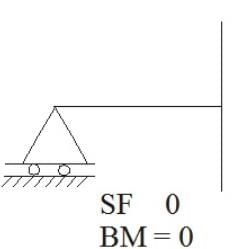
Real Beam
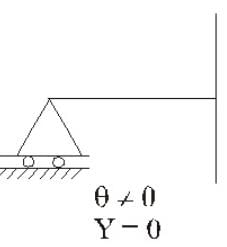
So, hinged support in real beam remains as hinged support in the conjugate beam.
The recommended camber for water-bounding Macadam road is- a)1 in 40 to 1 in 50
- b)1 in 33 to 1 in 40
- c)1 in 25 to 1 in 33
- d)1 in 20 to 1 in 25
Correct answer is option 'B'. Can you explain this answer?
The recommended camber for water-bounding Macadam road is
a)
1 in 40 to 1 in 50
b)
1 in 33 to 1 in 40
c)
1 in 25 to 1 in 33
d)
1 in 20 to 1 in 25
|
|
Aisha Gupta answered |
The recommended camber for water-bounding Macadam road is 1 in 33 to 1 in 40
Hence the correct answer is option B.
Broadly spaced contour lines on a map show that the area is- a)Flat
- b)Steeply-Sloped
- c)Vertical cliff
- d)Overhang Cliff
Correct answer is option 'A'. Can you explain this answer?
Broadly spaced contour lines on a map show that the area is
a)
Flat
b)
Steeply-Sloped
c)
Vertical cliff
d)
Overhang Cliff
|
|
Ankush Thakur answered |
When contour lines are broadly spaced it means we don't require much information about that area as the area is flat
on the other side if contour lines are more in number closely spaced it means every single detail of that area is needed for consideration of project
.
hence more no of contour lines means more info about the topography of that area.
on the other side if contour lines are more in number closely spaced it means every single detail of that area is needed for consideration of project
.
hence more no of contour lines means more info about the topography of that area.
Chapter doubts & questions for Full Mock Test Series - SSC JE Civil Engineering 2025 Mock Test Series 2025 is part of Civil Engineering (CE) exam preparation. The chapters have been prepared according to the Civil Engineering (CE) exam syllabus. The Chapter doubts & questions, notes, tests & MCQs are made for Civil Engineering (CE) 2025 Exam. Find important definitions, questions, notes, meanings, examples, exercises, MCQs and online tests here.
Chapter doubts & questions of Full Mock Test Series - SSC JE Civil Engineering 2025 Mock Test Series in English & Hindi are available as part of Civil Engineering (CE) exam.
Download more important topics, notes, lectures and mock test series for Civil Engineering (CE) Exam by signing up for free.
SSC JE Civil Engineering 2025 Mock Test Series
1 videos|1 docs|64 tests
|

Contact Support
Our team is online on weekdays between 10 AM - 7 PM
Typical reply within 3 hours
|
Free Exam Preparation
at your Fingertips!
Access Free Study Material - Test Series, Structured Courses, Free Videos & Study Notes and Prepare for Your Exam With Ease

 Join the 10M+ students on EduRev
Join the 10M+ students on EduRev
|

|
Create your account for free
OR
Forgot Password
OR
Signup to see your scores
go up
within 7 days!
within 7 days!
Takes less than 10 seconds to signup

